How robotaxis are trying to win passengers' trust
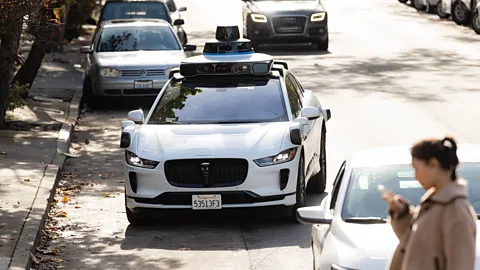 Getty Images
Getty ImagesAutonomous vehicles are already clocking up millions of miles on public roads, but they face an uphill battle to convince people to climb in to enjoy the ride.
A few weeks ago, I took a tour of San Francisco in one of Waymo's self-driving cars. As we drove around the city, one thing that struck me was how comfortable people had become with not seeing a driver. Not only were there multiple driverless vehicles on any given street at any given time, but tourists no longer had their mouths agape as one drove by. The technology has become a familiar sight.
Inside the vehicle itself, there were signs of how Waymo is trying to inspire a similar feeling among their passengers. The all-electric car offers a warm welcome to passengers by name and plays music as they climb inside. A screen positioned in front of the rear seats offers those along for the ride the option of seeing a follow-along map of the route, as well as settings for temperature and music. Another screen beside the steering wheel shows images of what's around the vehicle. As we drive, I can see people sitting inside buses alongside us, dogs crossing the street ahead and children skipping along the sidewalk.
Waymo wants you to see what the vehicle can – it wants you to trust it.
It is part of a wider trend within the autonomous ride-hailing industry. The technology allowing these self-driving vehicles to weave their way through busy city traffic is being used out there in a handful of cities around the world. What Waymo and its competitors need to do is to convince passengers to climb inside them.
Yet, research seems to suggest that the public in the US and the UK are reticent about riding in self-driving vehicles, with safety being among the most common concerns. A lot of it comes down to the trust people are willing to place in the technology and the companies that build the vehicles. But also there seems to be a higher bar when it comes to attitudes on the safety of autonomous vehicles compared to conventional cars.
For Waymo, the solution is to instill confidence in the robotic systems driving the vehicle.
"There is something very important about being able to know where the car is going, that the car sees what you're seeing," says Megan Neese, Waymo's head of product and customer research, from beside me during our tour of San Francisco. The company plans to keep the seats forward-facing with a steering wheel in its next generation car, she says. It's a familiar set-up in traditional taxis and that ability to see where the car is going helps people trust the car, she says.
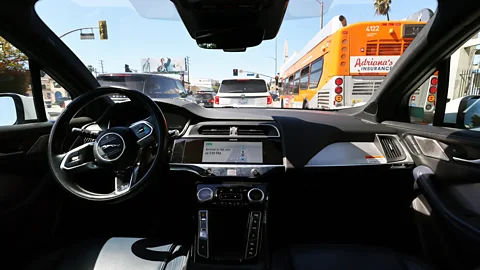 Getty Images
Getty ImagesWaymo, which is owned by Google's parent company Alphabet, began offering robotaxi services in the US without a safety driver on board in 2020. It now provides 150,000 paid rides a week across San Francisco and Los Angeles in California, and Phoenix in Arizona.
In the grand scheme of ride-sharing, it is still small scale – Uber claims to facilitate around 200 million trips every week worldwide – but the market is growing.
It is also highly competitive. Ensuring passengers are at ease and comfortable is likely to be where much of the battle will be fought.
Amazon-backed Zoox, which plans to enter the market in 2025, is taking a different approach to gaining consumer trust. It aims to let passengers lose themselves in the ride by not seeing what's ahead or what the autonomous driver can see.
Weeks after my Waymo ride-along, Zoox invited me to try their test vehicle at their Foster City headquarters outside of San Francisco on a prescribed course between two office buildings. Needless to say, it was a very different experience than riding Waymo in the wild, across a densely urban environment.
Zoox's offering is a purpose-built vehicle that is bi-directional, with no forward-facing or rear-facing windows. There is also no steering wheel, no pedals and no display screens to show the vehicle's surroundings. Instead, four seats face each other, bay seating-style. On either side there are sliding doors featuring large windows. A small screen next to each passenger allows them to personalise temperature controls and select music while a wireless charging pad sits on a flat divider between the seats. The vegan leather seats are dark green and the ceiling has twinkling lights set into it. It felt like a Disneyland ride.
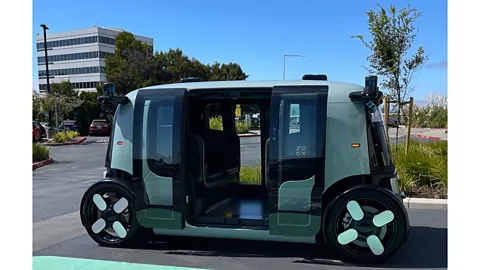 Martine Paris
Martine ParisTo help gain consumer trust, Zoox has also begun publicly revealing details of its Fusion Center, where human operators can provide guidance to vehicle remotely to get it out of an unfamilar situation – which the company describes as a little like laying a path of digital breadcrumbs for it to follow. During testing, the company says its vehicles received remote guidance for 1% of the total driving time.
Waymo previously did not talk publicly about its teleoperations centre, but earlier this year revealed it too has humans on hand to dial in to provide assistance. But rather than using remote drivers, Waymo's Fleet Response team answers questions from the autonomous vehicle about the choices it should make in ambiguous situations.
By comparison, General Motors-owned Cruise lost its permit to operate in California and had to pause operations after one of its vehicles dragged a pedestrian for 20ft (6m) after they were thrown into its path in October 2023. Since the incident, the company has been keen to highlight the layers of human support it uses with its vehicles. These include a team of fleet monitors, remote assistance and on-the-ground personnel to provide in-person assistance. Cruise says that prior to its operational pause last year, its vehicles connected to the remote assistance teams 3% of the time they were driving autonomously in urban environments, but that intervention wasn't necessary on all those occasions. The company says remote assistance provided "on-road support" for 0.6% of total autonomous driving time.
Cruise's chief executive and co-founders resigned a few months after the accident, while 900 other employees were laid off. The company has since resumed testing with safety drivers behind the wheel in Phoenix, Arizona and Dallas, Texas. It has also struck a multiyear deal to bring its cars onto the Uber platform.
More like this:
While self-driving taxis are being tested in many parts of the world, their deployment is most advanced in the US and China. Dozens of cities have approved trials of robotaxis on public roads in the US.
Waymo currently has the largest fleet in the US with more than 700 cars in San Francisco, Los Angeles and Phoenix. It's the only paid robotaxi service in the US and is expected to start offering a service in Austin and Atlanta during 2025, in partnership with Uber.
Zoox eventually plans to offer rides in San Francisco, after months of testing on roads for its employees. Zoox is also testing in Las Vegas, Seattle, Austin and Miami.
Cruise has yet to announce when it may open up its service to the public and is currently continuing testing in Phoenix, Houston and Dallas. Other autonomous services in development include Toyota-backed May Mobility, which has city-funded deployments across Arizona, California, Florida, Georgia, Michigan, Minnesota and Texas. Meanwhile, Chinese robotaxi giants AutoX and WeRide have permits to operate in California.
China leads the world in terms of the number of autonomous vehicles being tested on the road. The authorities there say they have issued around 16,000 licences for self-driving cars and buses in more than 20 cities. In Beijing, 33 companies have been given the green light to conduct trials within a vast 1,160 sq mile (3,000 sq km) area, according to officials.
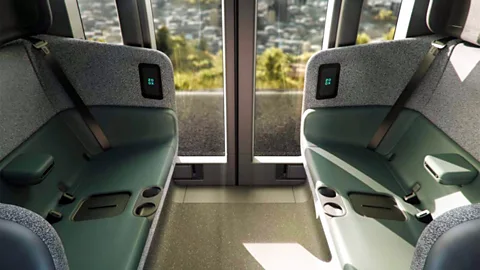 Zoox
ZooxChina's largest robotaxi operator is AutoX – backed by Chinese technology giant Alibaba – with a fleet of autonomous vehicles in Beijing, Guangzhou, Shenzhen and Shanghai. Baidu's Apollo Go – which operates fully driverless ride-hailing services in the cities of Beijing, Shenzhen, Wuhan and Chongqing – has been trying to win its customers over with low prices, sparking some complaints from local taxi drivers. Earlier this year, one of the company's driverless taxis collided with a pedestrian when they stepped into the road at some traffic lights. Although the person was not injured, it sparked questions about the technology's ability to deal with unexpected situations.
A spokesperson for Apollo Go insisted that safety of all road users was a top priority for the company and that its vehicles have accumulated more than 62 million miles (100 million kilometres) of autonomous driving in real-world situations without major accidents.
Apollo Go has faced other public perception problems, with mishaps involving its vehicles spreading quickly on social media in China. In one incident, a robotaxi caused a traffic jam after stopping for a plastic bag in the road, while on another occasion two autonomous vehicles became stuck in a polite standoff where they both tried to give way to the other.
The software that the cars run on, however, now has a "plastic bag misdetection" feature built into it, and Apollo Go says its sixth-generation robotaxis launched this year carry enhanced software and hardware.
Much like Waymo's robotaxis in the US, the Apollo Go vehicles feature a screen that shows a view of what the car's cameras can see or a map-like view with other road users detected by the car's sensors marked on it.
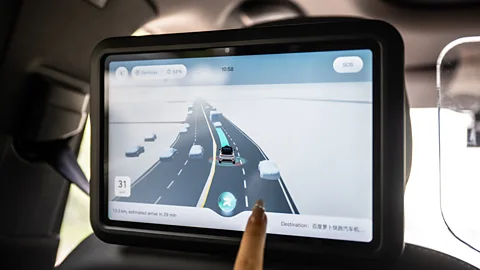 Getty Images
Getty ImagesWhile passengers in only a handful of cities in China and the US are now able to hail robotaxis, testing of autonomous vehicles is taking place in many other parts of the world. Japan is getting ready for its first robotaxi deployment in Tokyo with Tier IV due to launch its service this month. May Mobility, which has been offering rides in a handful of locations around the US, also launched in Nagoya, Japan, in early November, but they still require a safety driver in the front seat. They appear to be targeting older people as the main market for an autonomous ride-hailing service. "Roughly one-third of Japan's population is aged 65 and older," says a spokesperson for May Mobility. "This has led to more retirees and more people needing transportation assistance, yet many transportation operators face hiring challenges. AVs can help the elderly and others have a reliable and safe option to get around town."
Pilots of autonomous vehicles have also started in Singapore, South Korea, Australia, New Zealand, France, Germany, Norway, Sweden, Switzerland and the UK.
With the Autonomous Vehicles Act passing in the UK, robotaxis are expected to hit British roads by 2026. Croatian-startup Verne has partnered with Intel's Mobileye on a car with no steering wheel and seating for two, which is expected to rollout to 11 cities across the EU, UK and Middle East, including Manchester, England. One key feature it says it will introduce to its vehicle is a physical switch that customers can use to start and stop the ride. It is an attempt to give passengers a sense of control over the vehicle, the company says.
While it is clear that some people are willing to jump in a self-driving taxi as readily as a normal rideshare, winning over those who still have doubts will be essential for the gambles being taken on autonomous vehicles to pay off.
As the regulatory environment catches up with the technology in many parts of the world, convincing passengers in sufficient numbers to create the scale needed to turn a profit is still a challenge.
GM recently reported a $435m (£342m) loss on Cruise this quarter despite having paused operations for the past year.
Motional – a robotaxi firm partially backed by Hyundai Motor Group – reached 100,000 rides via the Uber and Lyft platforms in Las Vegas before the project was halted in May 2024 with sweeping layoffs. Karl Iagnemma, Motional's chief executive, acknowledged the challenges facing the industry.
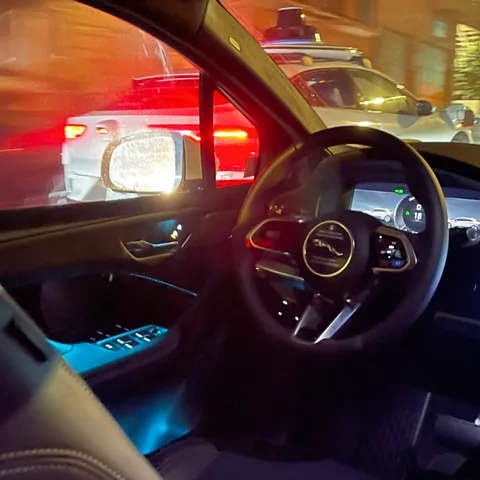 Martine Paris
Martine Paris"Large-scale driverless deployment will not happen overnight," he says. "While we're excited by our pace of technical progress, and our initial commercial deployments have yielded valuable insights, large-scale deployment of AVs remains a goal for the future, not the present."
Waymo is also short of its stated goal of serving one million trips per day with 20,000 cars.
But new actors are still entering the robotaxi market, with Elon Musk's Tesla announcing its long-awaited Cybercab robotaxi. The vehicle will not have a steering wheel or pedals and is not expected to go into production until 2026. Prior to the announcement, however, Musk also announced that he intends to give Tesla owners the opportunity to rent out their own vehicles as autonomous taxis as early as late 2025, with testing already underway in the San Francisco area.
"For Tesla employees in the Bay Area, we already are offering ride-hailing capabilities," Musk said. "With the development app, you can request a ride, and it will take you anywhere in the Bay Area. We do have a safety driver for now."
Regulatory approval for such a scheme, however, is far from guaranteed. As of November 2024, Tesla only holds a permit to test autonomous vehicles with a safety driver behind the wheel in California. Musk, who now holds a position within President-Elect Donald Trump's administration, has said he is going to push for updated autonomous vehicle legislation.
Mary Barra, chief executive at GM, recently spoke of her own frustrations with the regulatory approvals system at the TechCrunch Disrupt conference. Federal road safety regulations, for example, require a steering wheel and airbags in cars.
"I personally had been working with policy makers to get legislative change, because you have to change Federal Motor Vehicle Safety Standard laws," Barra said. "And I've probably been working on it for six, seven years now."
But the biggest battleground in the robotaxi race may be winning public trust. With many different approaches on offer, it may be some time before the less adventurous paying passengers feel happy enough to sit back and enjoy the ride.
--
For more technology news and insights, sign up to our Tech Decoded newsletter, while The Essential List delivers a handpicked selection of features and insights to your inbox twice a week.
For more science, technology, environment and health stories from the BBC, follow us on Facebook, Xand Instagram.
